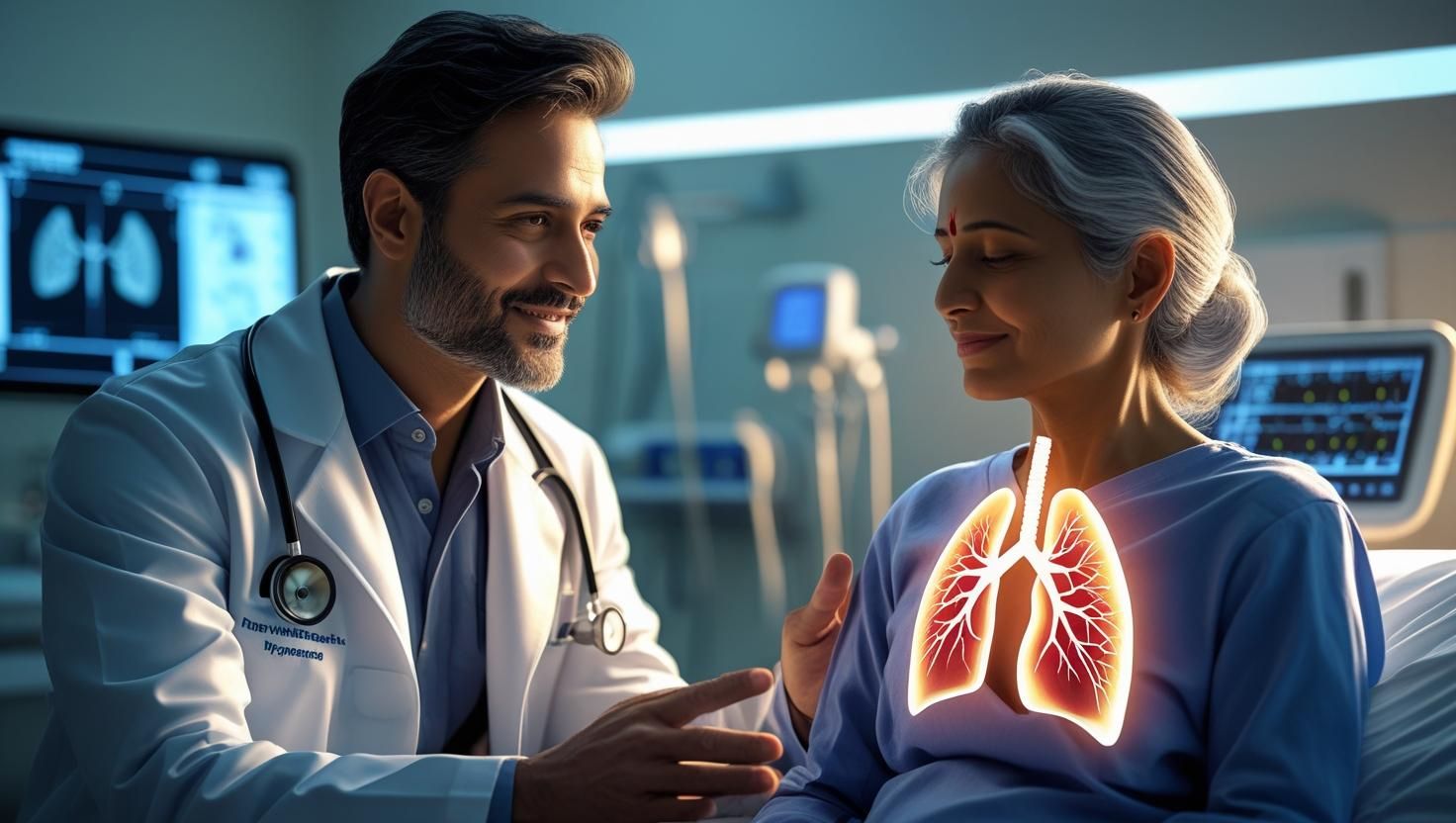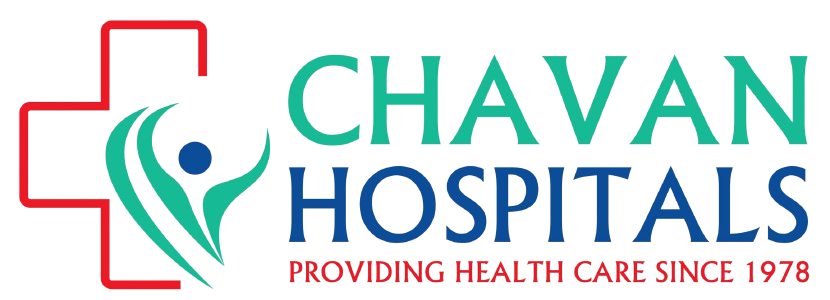- Home
- About us
- Specialities
Superspeciality
- Doctors
- Resources
- Contact us
Lung Cancer: Symptoms, Causes & Treatment at Chavan Hospital
At Chavan Hospital, a leading cancer hospital in Balapur, Hyderabad, we have seen how early detection and expert care can transform patient outcomes. With advanced diagnostic testing, state-of-the-art treatment facilities, and a committed oncology team, we empower patients to face this challenging condition with confidence, hope, and purpose.

What is Lung Cancer?
Uncontrolled proliferation of aberrant cells in one or both lungs is a hallmark of lung cancer, a dangerous and frequently severe illness. The lining of the bronchi or other lung regions like the bronchioles or alveoli are frequently where it starts. Malignant cells can invade neighboring tissues or spread (metastasize) to distant organs including the liver, bones, or brain, resulting in tumors that impair lung function. Due in large part to delayed detection, lung cancer continues to be one of the top causes of cancer-related fatalities globally.
Causes of Lung Cancer
While smoking is the most significant risk factor, causing up to 80%–90% of lung cancer cases, it is not the only one. At Chavan Hospital, our comprehensive assessments account for all potential causes, including:
- Tobacco smoking: Cigarettes, cigars, or pipes introduce carcinogenic substances into lung tissue.
- Secondhand smoke: Breathing in smoke from others can also significantly raise cancer risk.
- Radon gas exposure: A naturally occurring, odorless, radioactive gas that accumulates indoors.
- Occupational hazards: Exposure to asbestos, silica dust, uranium, or industrial chemicals increases risk.
- Air pollution: Long-term inhalation of particulate matter (PM2.5) or industrial pollutants contributes.
- Genetic susceptibility: Family history of lung cancer may indicate genetic predisposition.
- Previous cancer treatment: Prior radiation therapy to the chest increases risk in the long term.
- Infections like tuberculosis: Chronic lung inflammation may elevate risk in some patients.
At Chavan Hospital, we tailor our screening and risk assessment protocols based on individual patient history and exposure, ensuring early identification and appropriate monitoring.
Symptoms of Lung Cancer
Early-stage lung cancer may not cause noticeable symptoms, which is one reason many patients are diagnosed when the disease is advanced. However, once symptoms emerge, they may include:
- Persistent cough that does not improve, or chronic cough in smokers that worsens
- Dyspnea (shortness of breath) or wheezing
- Chest pain that worsens with deep breathing, coughing, or laughter
- Hemoptysis (coughing up blood or blood-streaked sputum)
- Unexplained weight loss accompanied by fatigue or appetite loss
- Frequent respiratory infections like bronchitis or pneumonia that recur
- Hoarseness of voice, particularly if the recurrent laryngeal nerve is affected
- Bone pain or swelling, suggesting spread to bones
- Headaches or neurological symptoms, indicating possible brain metastasis
Recognizing these warning signs—especially prolonged cough or hemoptysis—is essential to prompt medical evaluation at Chavan’s specialized oncology clinic.
Types of Lung Cancer
Lung cancers are broadly classified into two main categories based on cell characteristics and growth patterns:
1. Non-Small Cell Lung Cancer (NSCLC)
This is the most common type, accounting for nearly 85% of cases. Subtypes include:
- Adenocarcinoma: Originating in mucus-secreting cells; more common in non-smokers.
- Squamous cell carcinoma: Develops in the bronchial lining; closely linked to smoking.
- Large cell carcinoma: Fast-growing with early spread; typically necessitates aggressive treatment.
2. Small Cell Lung Cancer (SCLC)
This less common form makes up about 10%–15% of cases. It is highly aggressive, with early metastasis to lymph nodes, adrenal glands, liver, and brain. While it responds well initially to chemotherapy and radiation, recurrence is also common.
At Chavan Hospital, we rely on precise pathological classification via lung biopsies, guiding targeted protocols that offer the best chances of remission.
How to Diagnose
Diagnosing lung cancer involves a sequence of tests to confirm disease, assess its stage, and guide treatment:
- Chest X-ray: May reveal lung masses but lacks sensitivity for early nodules.
- Computed Tomography (CT) Scan: High-resolution scans detect small lesions and assess lymph node involvement.
- Positron Emission Tomography (PET)-CT: Identifies metabolically active tumors and distant metastases.
- Bronchoscopy: Enables direct visualization of airways and allows biopsy retrieval.
- Biopsy (via bronchoscope, CT-guided needle, or surgical sampling): Required for histological and molecular diagnosis.
- Molecular testing for genetic mutations (EGFR, ALK, ROS1, PD‑L1): Determines eligibility for targeted and immunotherapies.
- Pulmonary Function Tests (PFTs): Evaluate lung capacity to assess fitness for surgery or treatment planning.
At Chavan Hospital, all diagnostic modalities are available in-house with rapid turnaround. Our tumor board—including oncologists, radiologists, pathologists, and allied specialists—reviews each case to determine the optimal plan.
Treatment Options for Lung Cancer
Lung cancer treatment at Chavan is personalized based on stage, cancer type, patient health, and preferences. Our multidisciplinary strategies include:
Surgery
For early-stage NSCLC, surgery is the most effective curative option:
- Lobectomy (removal of a lung lobe) is the most common and often curative.
- Segmentectomy or wedge resection may suit small tumors in patients preserving lung function.
- Pneumonectomy is rarely performed but may be required for centrally located tumors.
Each procedure is performed in our advanced operating rooms, prioritizing patient safety and optimal recovery.
Radiation Therapy
An option for both operative and non-operative candidates:
- Stereotactic Body Radiotherapy (SBRT) is ideal for early-stage NSCLC in patients unsuitable for surgery, offering high cure rates.
- Conventional radiotherapy is used for locally advanced disease or palliative relief.
Chavan Hospital’s radiation oncology unit features precision technologies like IMRT and IGRT, minimizing damage to healthy tissue.
Systemic Therapies
Essential for advanced cases or specific molecular profiles:
•Platinum-based chemotherapy is still the mainstay for metastatic non-small cell lung cancer and small cell lung cancer.
•Targeted therapy, which has notable and frequently long-lasting effects, for cancers with EGFR mutations, ALK rearrangements, ROS1, or BRAF mutations.
• PD-1 or PD-L1 inhibitor-based immunotherapy, such as pembrolizumab or nivolumab, uses the immune system to target cancer cells, extending survival.
Our oncology team helps patients navigate side effects, dosing schedules, and combination treatments for the best outcomes.
Supportive and Palliative Care
Regardless of stage, we emphasize quality of life. Services include:
- Pain relief
- Nutritional support
- Psychosocial counseling
- Respiratory therapy
- End-of-life care when needed
These services ensure patient comfort and dignity while fighting cancer.
Survival Rate
Survival depends on type, stage, treatment, and patient health. At Chavan Hospital:
- Early-stage NSCLC: 5-year survival rates up to 60%–80% with surgery and adjuvant therapy.
- Stage III NSCLC: Improved outcomes with combined treatment approaches.
- SCLC: Aggressive treatment extends median survival to ~12–16 months; long-term remission can be achieved in some limited-stage cases.
Our institutional data and published outcomes highlight how advanced, coordinated care can significantly enhance survival and quality of life.
FAQ's
Is lung cancer curable?
Yes—especially in early-stage NSCLC detected before spread. At Chavan Hospital, surgical removal followed by targeted therapy and follow‑up often leads to long-term remission.
What are the early signs?
Early symptoms include persistent cough (more than 2–3 weeks), shortness of breath, chest pain that worsens with coughing or breathing, and unexplained weight loss. Any of these should prompt immediate medical attention.
Can nonsmokers get lung cancer?
Yes. Nonsmokers may develop lung cancer due to radon exposure, air pollution, genetic mutations, or secondhand smoke. Molecular testing is particularly important in these cases.
How often should you screen for cancer?
High-risk individuals—such as heavy smokers aged 50–80 with a history of at least 20 pack-years—should undergo annual low-dose CT scanning. At Chavan, we offer risk-based screening programs to detect lung cancer early.
Why Choose Chavan Hospital
Although lung cancer can seem hopeless, it doesn’t have to be a losing battle anymore thanks to early identification and cutting-edge treatment. As the top cancer hospital in Balapur, Hyderabad, Chavan Hospital’s goal is to offer individualized, evidence-based, and compassionate care at every turn. Patients are never alone because of early assessment, cutting-edge diagnostics, targeted medicines, radiotherapy, precision surgery, and comprehensive support.
Make an appointment with Chavan’s oncology team right now if you or a loved one is worried about the signs or risk factors of lung cancer. One life at a time, we can combat lung cancer together and rebuild health.
Visit www.chavanhospitals.com
Book an appointment with our oncology department
Trust Chavan Hospital for excellence in cancer care—because every breath matters.
